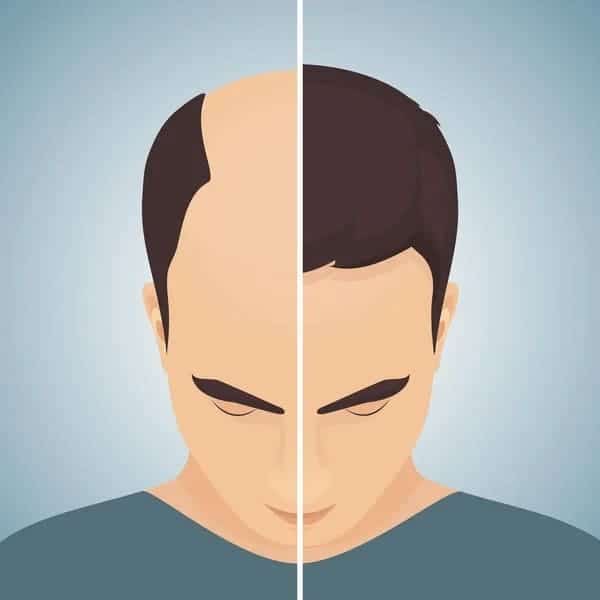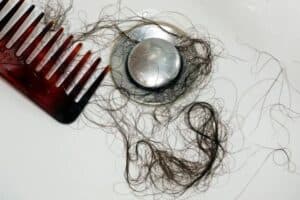Everything You Need to Know About Hereditary Hair Loss
One of the questions we’re asked every day is “is hair loss genetic”? Whilst hereditary hair loss is very common, there are also other hormonal and environmental factors affecting hair loss. On this page, you’ll find everything you need to know about hereditary hair loss, male pattern baldness, and what you can do to treat this form of hair loss.
Overview
Hair loss is a prevalent problem facing men and women across the UK. Hereditary patterned baldness, that is genetic hair loss, is the most common form of hair loss. However, hormonal changes and environmental factors also cause hair loss as well. Genetic hair loss is easily identifiable and there are several treatment options if you are affected.
Genetics and Hair Loss: What is the Link?
Hair loss is a prevalent problem affecting men and women. In the UK, it is estimated that 6.5 million men and 8 million women are suffering from hair loss. One of the leading causes of hair loss in men and women is down to a genetic condition called “androgenetic alopecia”.
Androgenetic alopecia is also commonly referred to as “male pattern baldness” or “female pattern baldness“. Although androgenetic alopecia is caused by the same inherited genetic variation, the condition manifests itself differently in men and women.
In a study conducted by Hagenaars et. al (2017), they found ‘a number of studies [to] have identified specific genetic variants linked to variations in baldness, usually with the AR gene showing the strongest association’. Although there is no definitive evidence to suggest the AR-gene (human androgen receptor gene) causes hair loss, it is likely the case that having this genetic variation puts a person at risk of pattern hair loss throughout their life.
Genetic hair loss accounts for roughly 80% of male hair loss cases (Hagenaars, 2017), whilst the causes of hair loss in women tend to be much more varied. Female pattern hair loss accounts for roughly 40% of female hair loss cases by middle age (Shannon 2015). So, while male hair loss is attributed to genetic hair loss, the causes of female hair loss are far more diverse.
What Role Does the (AR) Baldness Gene Play in Androgenic Alopecia?

The AR gene plays an important role in pattern hair loss. Having this gene predisposes a person to pattern hair loss conditions which can be gauged through hair loss scales such as the Hamilton-Norwood Scale and Ludwig scale.
The AR gene holds the necessary information for protein synthesis to occur in the body’s androgen receptors. Androgen receptors allow the body to process and break down hormones such as dihydrotestosterone (DHT), testosterone, and other androgens.
Studies have demonstrated that having the androgen receptor gene (AR) has been shown to increase the activity of your body’s androgen receptors in hair follicles. In turn, this predisposes a person (particularly men) to hair loss and hair thinning.
Although the speed of a person’s hair loss may be affected by hormonal changes and environmental factors, having the AR gene does make a person more likely to suffer from male pattern baldness.
While it may be upsetting to hear that there is a link between hair loss and the AR gene, it’s important to note that androgen receptors play a vital role in developing male sex characteristics, such as sex drive
During puberty, androgen receptors perform a vital role in responding to the body’s hormones and developing the body’s male sex characteristics (developing testes, broadening of the shoulders, regulating hair growth).
Male Pattern Baldness and Hereditary Hair Loss
One of the common names given to hereditary hair loss is a condition called “male pattern baldness”. Male pattern baldness is caused by genetic factors, including the AR gene.

For patients suffering pattern baldness, hair follicles shed in an easily predictable pattern. For men, this is usually visible through a receding hairline and then thinning on the crown area. For women, this is usually on the mid-parting line.
Hereditary hair loss caused by pattern baldness usually occurs over a long-term period. This process happens over years, if not decades. This type of hair loss is very slow and different from quick onset conditions such as alopecia areata that usually occur as a result of an immune system flare-up.
Genetic hair loss conditions also cause permanent hair loss. This means a sufferer will not see new hair growth in a previously balded area unless they have a hair transplant. This is markedly different to other environmentally caused hair loss conditions such as hair loss from stress and from nutrient deficiencies.
There is also no strict age that determines when a person will suffer from hereditary hair loss. Although pattern hair loss usually begins from the age of 25, cases of early-onset androgenetic alopecia are very common.
Environmental Factors That Worsen Hereditary Hair Loss
It’s not uncommon to see a person suffer from two hair loss conditions at the same time. While the baldness gene usually predisposes a person to hair loss at some point in their lifetime, environmental factors and hormonal changes (especially in women) can also worsen hair loss.
As our lives tend to get busier and busier, we can begin to feel more stressed. This has a series of consequences on our mental and physical health. One such side effect is that we can begin to lose hair. During stressful points in our lives, we often notice hair loss.
While stress itself may disrupt the hair growth cycle, several behavioural changes also occur as a result of stress that can worsen our pre-existing genetic hair loss conditions. Without even knowing it, behavioural changes from stress may be worsening your genetic hair thinning!
When we’re stressed, our diet can often not be filled with the correct nutrients needed to maintain a healthy balanced diet. This can cause the hair follicles to not receive the correct nutrients, causing hairs to become brittle and split. So, if you’re stressed, maintaining your hair health may slow down your genetic hair loss.

Moreover, when we’re stressed we may also enact behaviour that harms our body. Nail biting, scratching, and pulling out our hair are all common symptoms of stress. Having a hair-pulling disorder can worsen pre-existing genetic hair loss
If you think you may be genetically predisposed to the baldness gene, then one of the things you should prioritise is limiting stressful environments, prioritising a well-balanced diet and making sure you do not engage in actions that will disrupt your hair health.
Genetic Hair Loss Symptoms
If you want to spot signs of genetic hair loss, then it is wise to be on the lookout for common symptoms associated with pattern baldness. We’ve derived this list to help you determine what symptoms you may be suffering with:
- Receding Hairline – If you are a male suffering from a receding hairline, then this is an obvious sign of androgenetic alopecia.
- Crown Thinning – if you think you are losing hair in the crown area, then this is also an indication that you may have one of the genes linked with hereditary hair loss.
- Thinning Hair – if you notice that your hair is beginning to look less thick and full, especially on the crown or temple area, then this is a giveaway when it comes to suffering from genetic hair loss.
- Loosening of Hair Follicles – if you notice hairs on your pillow or the shower, this may be an indication that you are suffering from hair loss.
Are there any symptoms that could rule our genetic hair loss? Actually, yes! Suffering from the following symptoms would suggest that you are not suffering from genetic hair loss, but another condition. Here are some common hair loss symptoms NOT associated with genetic baldness:
- Patchy Hair Loss – if you are beginning to notice bald spots in your hair, this could indicate alopecia areata. This is a temporary hair loss condition and not genetically caused.
- Dry or Irritated Scalp – if you are suffering from dryness, itching, or irritation on the scalp then this may be a sign of an allergy or dermatitis. While this would make genetic hair loss unlikely, it would be wise to consult with a GP or medical practitioner.
If you’re suffering from any of these symptoms, be sure to book yourself a free consultation with one of our doctors who is experienced in diagnosing and treating all forms of hair loss in men!
Concluding Remarks
One of the leading causes of hair loss in men and women is a condition called androgenic alopecia. These pattern hair loss conditions are genetically driven and there is strong scientific evidence to link MPB and FPB to the AR baldness gene.
While genetic prediction does increase your risk of hair loss, there are several measures a person can take to slow down or even counteract their genetically motivated pattern hair loss. These include, minoxidil, finasteride, and hair transplants.








